Darmera peltata
 Darmera peltata
Darmera peltata
(dar-MARE-ah pell-TAY-tuh)
Syn. Peltiphyllum peltatum; Saxafraga peltata
Family: Saxifragaceae
Common name: umbrella plant; Indian rhubarb
Zone: 5 – 7
Height: 3 – 5 ft (0.9 – 1.5 m)
Spread: 3 – 5 ft (0.9 – 1.5 m)
Aspect: sun; partial shade; full shade
Soil: humus-rich; moist; average; clay
Water: regular; moderate
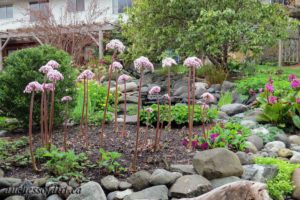 Description: Herbaceous perennial with thick rhizomes. Small pink and white flowers in terminal, rounded corymbs appear atop thick stems in early spring before the foliage. Large, 18-inch (45 cm) wide, medium green, rounded, lobed leaves with serrated edge follow the blooms, forming a large mound which lasts throughout the season with regular watering. Stunning foliage colour in autumn.
Description: Herbaceous perennial with thick rhizomes. Small pink and white flowers in terminal, rounded corymbs appear atop thick stems in early spring before the foliage. Large, 18-inch (45 cm) wide, medium green, rounded, lobed leaves with serrated edge follow the blooms, forming a large mound which lasts throughout the season with regular watering. Stunning foliage colour in autumn.
Special Notes: Native to mountain streambanks and woodland areas in SW Oregon and northern region of California. Prefers medium to wet soil conditions in part to full shade but tolerates average and clay soils with regular watering. Will also tolerate full sun locations if plant is kept consistently moist.
The tall leaf stalk, or petiole, is attached in the centre underside of the large leaf which creates a shallow cup-shape. This allows the upward facing leaves to collect a small pool of rain water. Various insects often avail themselves of a drink.
This plant species spreads exponentially by rhizamous roots so give it adequate space. It is ideal for moist, boggy areas, as well as assist in stabilizing sensitive stream and pond margins. No serious insect or disease problems. Propagation by division.
In our Zone 7a garden: This plant has pride of place in its own bed beside our pond. It is in a full sun location and is watered regularly so we can attest to its stunning autumnal display.
We have not experienced any problems with the exception its spread will exceed 5 feet (1.5 m) which necessitates reducing its size every 5 to 7 years.
Great Plant Pick 2008
Posted on June 12, 2024; updated on February 19, 2025
Cyclamen coum
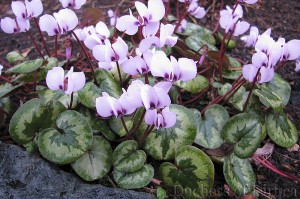 Cyclamen coum
Cyclamen coum
(SIK-la-men KO-um)
Family: Primulaceae
Common name: Persian violet, eastern sowbread
Zone: 5 – 9
Height: 3 – 6 in (7.5 – 15 cm)
Spread: 6 in (15 cm)
Aspect: sun; partial sun; shade
Soil: fertile; humus-rich; well-draining
Water: drought tolerant once established
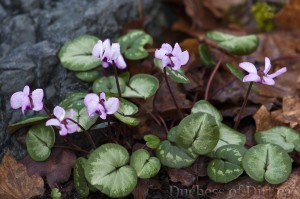 Description: Tuberous perennial with round or heart-shaped dark green leaves which may have some silver or grey markings. Flower colour ranges from white through shades of pink with darker staining at the base of the petals. This is a spring ephermeral…flowering from December through March, depending on region, and going dormant through the summer.
Description: Tuberous perennial with round or heart-shaped dark green leaves which may have some silver or grey markings. Flower colour ranges from white through shades of pink with darker staining at the base of the petals. This is a spring ephermeral…flowering from December through March, depending on region, and going dormant through the summer.
Special Notes: Native to the Mediterranean, this delightful winter-blooming perennial does well as an understory specimen in rhododendron, maple, birch, Douglas fir and western red cedar plantings.
Self-seeding, this plant naturalizes nicely with the help of ants who are attracted to the sugary coating on the seeds. Tiny seedlings start to appear in late fall. Once the plants are established, they are drought tolerant.
Generally, disease- and pest-resistant; deer resistant.
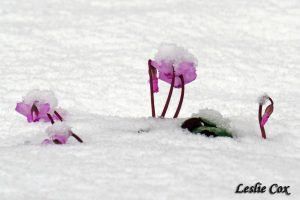 In our Zone 7a garden: I have a slowly increasing patch of Cyclamen coum flowers underneath the Acer campestre, (European hedge maple), which are purely delightful when they come into flower in the middle of winter for us.
In our Zone 7a garden: I have a slowly increasing patch of Cyclamen coum flowers underneath the Acer campestre, (European hedge maple), which are purely delightful when they come into flower in the middle of winter for us.
This bed in the garden landscape is a difficult one due to the maple roots sucking up all of the nutrients…leaving little for the other plants residing there. Because of this, I am always impressed by the plants who manage to survive such harsh treatment.
Awards: Named by the Royal Horticultural Society as one of the top 200 plants of the last 200 years.
Caution: Toxic to dogs and cats if ingested.
Posted on February 19, 2020; updated on February 11, 2025
Crocosmia ‘Lucifer’
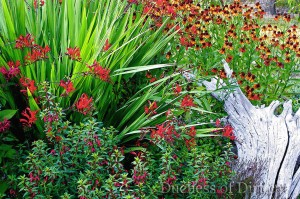 Crocosmia ‘Lucifer’
Crocosmia ‘Lucifer’
(kro-KOZ-mee-ah)
Family: Iridaceae
Common name: monbretia
Zone: 6 – 9
Height: 3 – 4 ft (90 – 120 cm)
Spread: 18 – 24 in (45 – 60 cm)
Aspect: full sun; partial shade
Soil: average; well-draining
Water: moderate
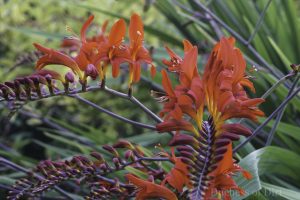 Description: An herbaceous perennial with a fairly upright, clumping habit. Medium green leaves, looking very much like long blades of grass, drape wonderfully in a vase-like form. Arching stems of eye-catching flame red, funnel-shaped flowers appear in mid-summer through autumn.
Description: An herbaceous perennial with a fairly upright, clumping habit. Medium green leaves, looking very much like long blades of grass, drape wonderfully in a vase-like form. Arching stems of eye-catching flame red, funnel-shaped flowers appear in mid-summer through autumn.
Special Notes: A native to South Africa, this is a good cut flower for floral arrangements. Attracts bees, butterflies and especially hummingbirds. Plant grows from corms. Seeds do not always come true. Seed is used largely in the production of new varieties. Established clumps should be divided every 3 – 4 years in spring or autumn. Few pests or disease.
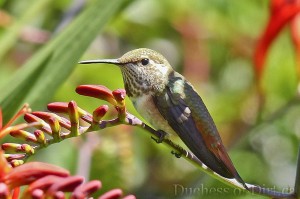 In our Zone 7a garden: We love this plant for the hummingbirds and butterflies it attracts to our garden. However, John does tend to curse it every so many years because he has left its necessary maintenance division too long. And when he finally gets around to it, digging it up out of the ground for dividing has turned into a real grunt job. He has to bring out the no-nonsense tools – drill steel and axe.
In our Zone 7a garden: We love this plant for the hummingbirds and butterflies it attracts to our garden. However, John does tend to curse it every so many years because he has left its necessary maintenance division too long. And when he finally gets around to it, digging it up out of the ground for dividing has turned into a real grunt job. He has to bring out the no-nonsense tools – drill steel and axe.
Honestly, when you have to start roping the mass of blade-like leaves to keep them from smothering the smaller plants surrounding ‘Lucifer’ you have to know you should have divided the Crocosmia last year…or the year before. But to give John his due credit, he is very meticulous in maintaining his horticultural display to perfection. There just are not enough hours in the day to get to everything.
RHS Award of Garden Merit 1993
Posted on August 16, 2012; updated on February 11, 2025
Corydalis solida
 Corydalis solida
Corydalis solida
(kor-ID-ah-liss SOL-ih-dah)
Family: Papaveraceae
Common name: fumewort; bird-in-a-bush
Zone: 4 – 8
Height: 6 – 10 in (15 – 25 cm)
Spread: 12 – 18 in (30 – 45 cm)
Aspect: full sun; partial shade
Soil: moderate; well-draining
Water: moderate
Description: A spring ephemeral perennial with a low mounding habit. Tuberous roots will slowly spread out to produce a soft carpet over time. Grey-green leaves are deeply divided and fern-like. Tubular-shaped flowers with an upswept spur sit atop a slender stalk. Floral colour can be blue-mauve to purple, or reddish and white. Whatever the colour, it will be consistent on one plant. Blooms mid-March through spring. Being an ephemeral, the plant completely disappears come summer.
Special Notes: Native to northern and central Europe and Asia where this plant grows in meadows and woodlands. British gardeners have been cultivating it in their gardens since late in the 16th century. Very easy care; relatively pest and disease free. Moderately drought tolerant, but does benefit from some watering. Deer and rabbit resistant. Propagation by division in early spring or by fresh seed in late spring. Seed needs a stratification period in dappled shade to germinate. Not deadheading the spent flowers right away is a guarantee you will have one or two new seedlings pop up the following year. (Try not to disturb the soil around your fumeworts too much or you may lessen your chances of new seedlings.)
In our Zone 7a garden: This plant was a new addition to my front garden in Spring 2015. A gift from a friend, it was broken into three clumps and planted under the Acer campestre (European field maple). Fast forward two or three years and it has become a lovely early spring presence in the bed outside the front room window. There is nothing like signs of growth and early flowers after the tough months of winter.
Posted on March 28, 2016; updated on February 5, 2025
Convallaria majalis
 Convallaria majalis
Convallaria majalis
(kon-vah-LAH-ree-ah mah-YAH-lis)
Family: Liliaceae; Asparagaceae
Common name: lily-of-the-valley; May lily; May bells; lady’s tears
Zone: 3 – 9
Height: 10 in (25 cm)
Spread: indefinite
Aspect: partial shade; full shade
Soil: fertile; moist; well-draining
Water: moderate
Description: An herbaceous perennial with a vigorous spreading habit. Elliptical, bright green leaves are upright in stature. A single stem arises from the centre of the plant in May from which dangle a multitude of wonderfully fragrant, pendulous, bell-shaped, white flowers. Red berries follow in summer.
Special Notes: Native to the temperate regions of North America, Asia and Europe. Good cut flower. Can be very invasive, especially in moist fertile soil, so best to keep this plant well contained. May have a problem with leaf spots. Leaves will turn brown on edges if plant is kept too dry. Deer and rabbit resistant. Propagate by fresh seed or by division in early spring or autumn.
In our Zone 7a garden: We grow this plant in a tiny bed at the foot of our back steps. Hemmed in by a concrete sidewalk and a concrete retaining wall keeps it from running amok. Every few years, we dig out a clump to ease the over-crowding. This keeps the patch looking nice and producing an abundance of blooms. And while I am talking about these deliciously scented flowers, I should also mention we get lots of blossoms even though our patch of lily-of-the-valley is in full shade. It is also under the overhang of the eaves in an area where we do not water.
The harsh conditions our Convallaria majalis plants are subjected to proves this species can take tough conditions and still throw out good blooms. Few things can surpass starting one’s day with a whiff of lily-of-the-valley as soon as you step outdoors.
Caution: All parts of the plant are toxic. Fatal if ingested in large quantities.
RHS Award of Garden Merit 1993
Posted on April 14, 2013; updated on January 29, 2025
